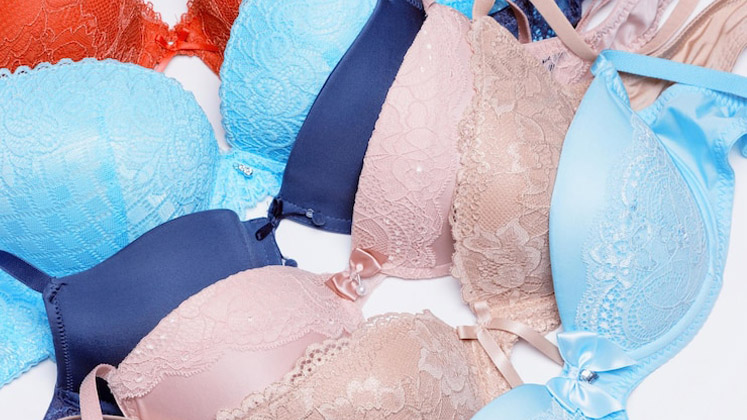The global lingerie market size is estimated to cross approximately US $ 84 billion by the end of 2028 according to various reports from around US $ 43 billion in 2020. Around 40 per cent market in lingerie segment is captured by entire Europe, while 30 per cent is shared by North America. When it comes to single largest lingerie market, USA stays ahead of other countries with import of brassieres reaching US $ 2.82 billion in 2021 and crossing pre-pandemic figures of US $ 2.26 billion in 2019.
Of total imports to USA, the contributions of countries such as China (33.40%), Vietnam, Indonesia, Sri Lanka and Bangladesh were significantly good and growing; however India’s performance was below par with just 1.90 per cent share (US $ 53.67 million) in the USA brassieres imports during 2021.
Not just USA, India hasn’t been able to tap European market too in lingerie segment that is nearly US $ 17 billion worth of market size during 2021. If India’s export figures are analysed, the country shipped just US $ 88.31 million worth of lingerie products during 2021.
While lingerie export segment may not be robust in India, the growing domestic retail segment in lingerie as well as innerwear is continuously evolving. Indian lingerie market is expected to be nearly double to US $ 11-12 billion by 2025 from US $ 7.50 billion in 2020 as incomes rise, more young women join the workforce and people become aware of better brands, said a report by consulting firm RedSeer.
Importantly, in 2021, India imported just US $ 38.07 million worth of lingerie products that indicates the market is still majorly dependent on domestic manufacturing to cater to massive demand. With the advent of domestic brands (many of these do have their own units too) like Clovia, Zivame, Groversons, Enamor (Gokaldas Intimatewear), Amante, Romance, Sona Lingerie, Triumph International; Pearl Intimates and Parfait, the lingerie segment is pegged to further grow and this is what domestic lingerie makers eye on! Not just lingerie, a lot of innerwear factories have established themselves as one-stop destinations for domestic brands over the years… Dollar Industries, Page Industries, Lux Industry, TT Ltd. and Rupa are some names that have captured a great chunk of the Indian innerwear segment.
When it comes to the manufacturing of a complex product such as lingerie, especially bra, not many factories across countries have gained required technical know-how to manufacture the same. The interactions between body shapes, pattern shapes and fabric properties i.e. in bras, can create an exponential number of possible fitting issues to be resolved and here comes the expertise of factories. This is what Nimish Dave, Founder, The Idea Smith – a manufacturing business consulting firm – indicates.
“If you study the product categories of 1,000 Indian exporters, you’ll find none of them – over past two, three decades – have ventured into the manufacturing of bra and presented themselves as capable players in the international market. And even if 1-2 per cent factories have done it, this is insignificant and does not really count when there are immense possibilities of growth in the export sector. This clearly says we are lacking the 3Cs – Capability, Capacity and Competence,” commented Nimish Dave.
Although India has quality apparel manufacturers for export market but, as far as brassieres’ exporters are concerned, there are only few names such as Ginza Industries; MAS Intimate, and Brandix (in Vizag).
Why is India lacking in lingerie export business?
- Lack of technical know-how…
Of all the products, women bra is arguably the most complex and most engineered product out there in the world. Margin of error to produce a bra is in micro-millimeter as it touches the most sensitive part of a woman anatomy for over 15 hours a day, whereas this tolerance is little higher in other products from consumer perspectives! So any cause of discomfort, however minor, will be quickly highlighted.
Much better mind; talent; competence; Industrial Engineering aspect; product know-how; massive attention to detailing to ensure not even a single product goes out of that micro millimeter tolerance band; obsessive control over checking of fabrics, elastic and hooks are precisely needed in an efficient lingerie factory; and sadly, as per Nimish, these all qualities are lacking in Indian lingerie factories…
Read more – https://apparelresources.com/business-news/manufacturing/manufacturing-bra-lean-setup/
When product know-how is considered, that’s one of the most critical requisites of lingerie manufacturing. Factories should know how end product will behave on different areas such as stomach, across underbust (as breast hangs over the underbust line many times that is avoidable), and chest (the appropriate chest gapping is always recommended but not many factories pay detailing to this parameter).
Substantiating on the same, Chandrajith Wikramasinghe, famously known as CJ, Founder of Corrigo Consultancy Pvt. Ltd., stated, “Bra manufacturing set-up is just like the set-up of other garment manufacturing units but it requires better technical know-how and compatibility of teams working on the project,” adding, “The factories that I and my teams have set up in Mumbai match the global standards of lingerie manufacturing. Corrigo has a complete set-up of technical lingerie team. We take over from factory designing till garment dispatch. We take control, run the factory for a year or two and build the complete local competencies. Then only we hand it over to the local management.”
- Unavailability of specialty fabrics is a real challenge…
Mainly, India has not been able to be called a good destination for lingerie export because of lack of raw material availability. Lingerie is a type of women’s clothing that is embellished to have an appealing and fashionable appearance while also being functional. The brassieres in the export market are frequently fashioned of textiles that are lightweight, stretchy, smooth, and decorative, such as silk, satin, lycra, charmeuse and other similar materials. Natural fibres such as cotton, as well as synthetic fibres such as polyester and nylon, are also used to make them.
“Of all these materials, only cotton and cotton lycra are easily available in India but the factories are always dependent on China for imports of synthetic materials. Additionally, there are only a few big manufacturers who adhere to the delivery timelines and the quality standards. For a small manufacturer to deal with these challenges is kind of difficult…Getting those materials imported, maintaining lead times, and dealing with China is not as easy as it seems. The factories in India with which I am working import a lot of material and they often report the fabric import handling is not easy and importing cost is too high,” commented CJ who has established some domestic lingerie factories in India such as Body Care Creations (Noida); Shalibhadra Creations (Mumbai); Juliet Apparels Private Limited (Mumbai) and Defiance Knitting Industries Ltd. (Ambernath).
There are around 20 pieces that go in bra making and everything has to match the colours right from fabrics, plastic, rubber to metal. “All these have to match the colour shade. That’s why nobody wants to get into it. Hence, raw material, trims and accessories have become major growth impediment factors for Indian factories in lingerie,” shared CJ.
Commenting on the same, VK Bajaj, Owner of Romance Bra – a home-grown domestic lingerie brand as well as manufacturing unit, stated, “If factories want to go for exports, they push themselves back as they lack technical know-how, unavailability of required fabrics as well as a proper set-up that’s used for establishing an export-oriented factory,” adding, “We used to make cotton bra, terry fabrics bra and then we moved on to making hosiery bra. But that’s not international fabrics standard. Adding to this is the fact that India doesn’t have nylon spandex dyeing facility as of yet. So we import that material from China and other countries so, due to all these challenges, inclination towards export is not there.”
However, today some factories have evolved and started using molded fabric to make bras, as briefed by Bajaj. “They have also started using foam cup that is one of the international standards. The companies are trying to establish dyeing units for nylon spandex fabrics in India itself…You will see that growing investment in synthetic fabrics production in our country will help us make fabrics like poly-spandex procure from Indian suppliers only within a year or so that will help gain trust of big retail conglomerates that are importing high-fashion bras from Bangladesh and other neighbouring countries,” opined VK Bajaj.
- Minimal understanding of Indian factories of what overseas buyers really want…
Lack of global understanding in factories dealing with bra segment such as consumer choosing more of body positivity and inclusivity today is another headwind. What factories really need to understand is the fact that there is a tremendous difference between what an export buyer demands in lingerie product and what an Indian consumer is being dished out.
“And I say it with reasonable sense of competence and experience as we have set two fantastic manufacturing plants for women lingerie in India. One of them is one of the best innerwear manufacturing factories in India called Abhinandan Creation in Mumbai…While it is extremely capable to service the needs of the domestic market, it would still be wanting to service global brands. The capability, competence and the requirement of that international level – even we would be challenged. If we are challenged after putting years of work, efforts, system, people, process, technology, compliances etc., rest of the industry will certainly be challenged,” commented Nimish.
Nimish further added, “I don’t want to belittle anyone but that’s true because most of them do not understand export dynamics. The mindset to export is a different equation vis-à-vis the mindset to serving the domestic innerwear brands. Sheer amount of social audits, environmental audits, real time visibility, communication, buyers’ demand, discipline and adherence to TnA, immense quality checks, lab testing… If you consider the entire length and breadth of India, there are only around 25 dyeing mills that really adhere to quality! And, as far as dyeing is concerned, European standards are quite challenging for an exporter. This is not asked by an Indian buyer or consumers.”
- Unskilled human resource/manpower adds to the woes…
In India, most SMEs factories are still run by ‘Masterji’ who have decades’ of experience in working on shopfloor. But beyond that experience, they lack in engineering, quality and establishing right systems, so factories need to ensure right skill level is groomed.
“So when we approach any factory, we bring in absolutely right talent on an engineering platform, even if he is needed to be hired from Sri Lankan innerwear manufacturing giants. In Abhinandan, the first four people that we hired were from Brandix and MAS Intimates. Our Maintenance in-charge who set up the entire plant and machinery is having experience of 7 years in Brandix. From Day-1, we had huge expectations in terms of efficiency, quality and right process. I disregarded the efficiency for a year and asked them to build quality first. Factories need to establish the right process. Since the focus of ours has been domestic business since the beginning, we never tried for export business but we are ready for it and are confident that global brands in lingerie will appreciate our efforts,” claimed Nimish.
Abhinandan has been working with Reliance Retail for a long time and now it has started to work with the Indian team of Jockey – a US-based renowned brand.
Growth in domestic lingerie segment will keep domestic factories engaged…
Advent of domestic lingerie brands is another reason why factories aren’t willing to get into export business… Many of the home-grown lingerie brands do have their own manufacturing set-ups too that are engaged catering to the needs of domestic fashion consumers such as Zivame. Its digital platform now contributes to 90 per cent of the business with robust demand – with over 50 per cent higher demand Y-o-Y coming in from Tier-3 and Tier-4.
Read more about growing Indian lingerie market here –
Evolving Indian lingerie market – A sneak peek
Global size-inclusive lingerie brand launches in India
A ‘Pretty’ Journey from An Online to An Offline Lingerie Brand
Enamor’s online share of the business grew to the tune of four to five times in 2021 on a year-on-year basis. As Enamor is a premium brand, hence, it gets most of the business from Tier-1 cities. However, the brand reports that the demand is now driven by most people adopting work from home (which includes those who returned back to their homes in Tier-2 and Tier-3 cities) which has contributed to the rise in lingerie sales.
As far as Clovia is concerned, the demand it sees is more from non-metro cities that have grown substantially in the last few years and which now experience lingerie sales between 7 to 7.50 lakh pieces per month.
“Domestic lingerie market has grown by leaps and bounds and that’s the reason why the capacities of domestic lingerie factories remain booked all throughout the year. In last couple of years, many factories have come up and are working with some good domestic brands. This domestic market will mature one day and then they will try their hands in exports,” believed CJ.
VK Bajaj had his say on this… According to him, there are 2 reasons behind domestic factories’ not moving to export business… “Domestic brands (except few) previously used to outsource lingerie products but a shift can be seen in last 3-4 years as more brands are coming up with their own units. We might not be making bras as per international standards today but we are evolving and continuously improving, especially in North India. Demand is already there and most of the domestic factories are overbooked. If I have such kind of demand in domestic market, why I would go for export…,” mentioned VK Bajaj who further said that, in North India alone, over 150 factories are involved in making lingerie products of which around 100 are reportedly working for Reliance Retail.
Apparel Resources (AR) suggests factories to look at underdeveloped and least developed countries to export lingerie products…
Developed countries have always been target markets for traditional apparel factories across major manufacturing countries and their focus hasn’t remained much on catering to the buyers of underdeveloped and least developed countries (LDCs) that are establishing themselves as emerging markets. The consumption of bras is on the rise in these countries because around 80 per cent of rural population in these countries were not using bras and sanitary napkins earlier but the trend is evolving now and a sense of growing awareness can clearly be seen amongst the women shoppers in these countries.
While analysing data, Team Apparel Resources could substantiate the above stated fact…Our team found that, during 2021, the brassieres import values of underdeveloped countries from India were minimal but the Y-o-Y change was whopping – Nepal (up 106.93%); Uganda (up 101.55%); Indonesia (up 426.75%); Kyrgyzstan (up 3,558.29%); Morocco (up 53.46%); and Nigeria (up 30.71%) technically but they had almost negligible lingerie imports from India until 2020, but 2021 has proved to be an evolving year for Indian factories and this growth should be continued…
One of India’s top garment exporters started a project 5 years ago to cater to M&S’s high-end lingerie orders, deployed senior people from Sri Lanka, invested hefty amount in technology, initiated the operation but then failed miserably and wrapped up operation in just under one year after starting the project! The reasons were – lack of right fabric procurement; supply chain management in a complete new product category; and workforce’s inability of producing a very much complex product than what they were already producing!







